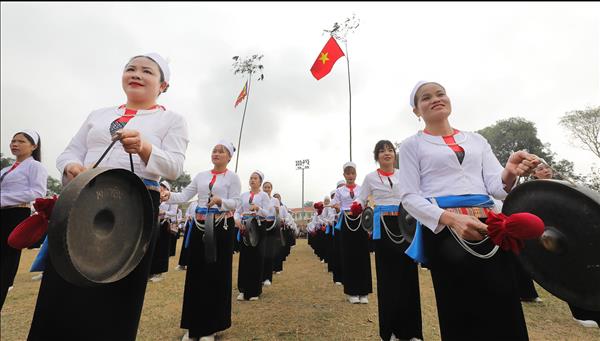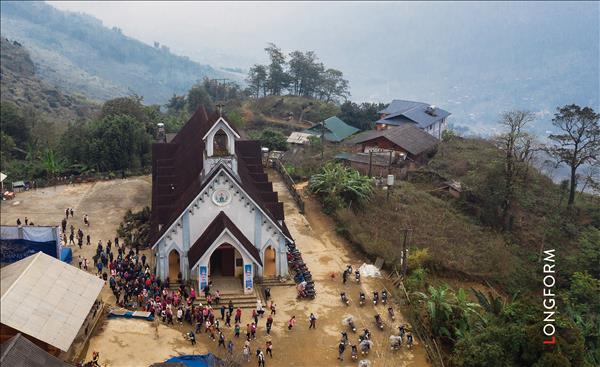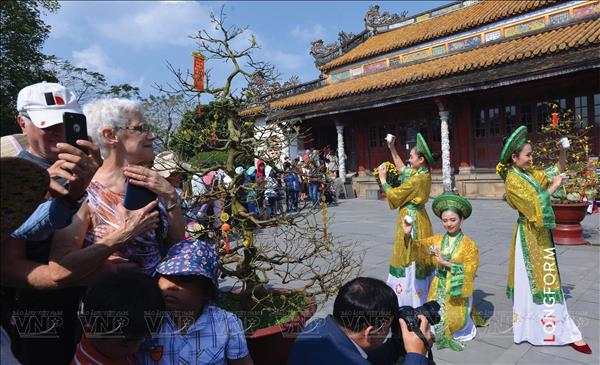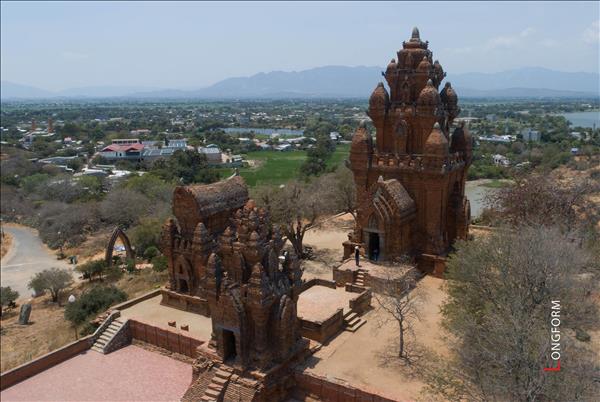E De, Co Tu, M’Nong, GiaRai and Ma consider gongs to be their treasures, their voices, and their innermost feelings and sentiments. Gongs are also sacred which help them communicate with their deities. Ten years after being recognised as an intangible and oral cultural masterpiece of humanity, Tay Nguyen gong culture space has further demonstrated its values, becoming the cultural “envoy” linking visitors from five continents with this basaltic land full of sunshine and winds of legendary Tay Nguyen forests and mountains.
The Call of Forests and Mountains
Every year, the third moon is the season when bees feed on the nectar of flowers and also the festival season of Tay Nguyen people of various ethnic groups. Following the call of forests and mountains, we returned to Tay Nguyen and Buon Ma Thuot city when the 6th Ban Ma Thuot Coffee Festival and the Tay Nguyen Gong Culture Festival 2017 were taking place.
In a festive atmosphere typical of the Tay Nguyen region, stories of coffee and gongs become subjects of discussions more than others.
12 years after the Tay Nguyen gong culture space was recognised as a world cultural heritage, interesting stories about this distinctive cultural and artistic genre are subjects for researchers and those who love to learn about the Tay Nguyen culture.
The gong performances that opened theTay Nguyen Gong Culture Festival 2017, which took place in Buon Ma Thuot city, were truly impressive. By the flickering fire and liquor jars, the gong teams of Xo Dang, Chu Ru, Ba Na, Co Tu, M’Nong, GiaRai and Ma performed bewitching and seductive gong tunes and melodies such as “Mung lua moi” (Happy with new rice), “Ta on” (Thanks giving), “Vui don khach” (Happily welcoming guests) and “Giu khach o lai choi cung” (keeping guests longer).
For Tay Nguyen ethnic people groups, gong tones and melodies are closely attached to lives of the locals. The sounds of gongs follow people from the time they are born to the time they breathe their last breath. Therefore, gongs are used at name-giving rites, new rice rituals, buffalo-stabbing rites, rain- praying rites, wedding ceremonies and house-warming parties. They are also the esoteric threads linking the earthly world with the divine world.
That is why Y Thim, a veteran of the gong culture village of E De people in Tay Nguyen, said: “Gongs constitute the soul of Tay Nguyen. They are always with people, from the time they are born, then during the name-giving rites, to the time they are grown up until the time they die”.
For the E De ethnic people, gongs are not only musical instruments but also invaluable assets. “You are not a wealthy person if you do not have gongs even though you have multi-storey houses and cars,” Y Thim added.
Perhaps, for that reason, Y Thim is considered rich in Buon Ma Thuot because he has 20 sets of precious gongs. He said, “My house is not a museum, only a place where precious assets of the E De people are kept for our children and grandchildren as well as students and also for visitors to see and learn more about our ancestors’ culture”.
During our journey to Tay Nguyen, we were lucky to meet with village patriarch Y Tong Drang in Jun hamlet, Lak district, Dak Lak province. He welcomed us in a tipsy state after imbibing the festival drinks of Ruou can (wine drunk out of a jar through pipes) and told us, “ In the old days, a set of M’Nong people’s gongs was sold at a price equivalent to 7- 8 buffaloes. It was so precious that M’Nong people neither gave nor lent them to anyone”.
During our stay in Jun hamlet, the village patriarch guided us to a ritual praying for an elephant’s health at Dang Nang Long’s house. In his capacity as sorcerer and owner of an elephant herd, Dang Nang Long revealed that Tay Nguyen people think that everything has a soul and only gong sounds can call and link souls together. In the rites of praying for an elephants’ health, without gong sounds, the elephants’ soul does not know where to go.
Dang Nang Long signalled the start of the rite with resounding gong tones. Surprisingly, giant and fierce elephants suddenly became gentle and well-behaved, obeying the mahouts’ direction and seriously joining in the rite without any trouble.
The interesting stories of Tay Nguyen gong culture led us to various areas of this windy highland. When travelling through each area, such stories were told more and more.
Tay Nguyen Calling Friends
Nowadays, gongs have become a peculiar cultural and tourist product of Tay Nguyen inhabitants. They constitute not only the thread linking hamlets together and humans with deities but also the sounds of hearts and souls of Tay Nguyen people calling friends from different regions of the world to discover the land rich in economic and cultural potentials.
That is why at a conference to promote investment in the Tay Nguyen region in 2017, Prime Minister Nguyen Xuan Phuc urged the local administration to work out a strategy on diverse tourist development, placing importance on the preservation of local culture represented by gong culture.
Fully aware of the role of gongs in cultural- tourist development, the authorities of Lam Dong, Dak Lak, Gia Lai, Kon Tum and Dak Nong provinces have recently made sound decisions and policies to preserve, maintain and develop the gong culture.
For instance in Da Lat, known as Tay Nguyen’s tourist “capital”, visitors have the chance not only to see beautiful places with clean air but also enjoy gong performances by Ma ethnic minority people in the Langbiang mountain region.
At the Tay Nguyen Gong Culture Festival 2017 in Buon Ma Thuot, visitors also had the opportunity to enjoy new tourist products of gong culture in four ancient hamlets of the E De people like Kram, Ale, Pan Lan and Ko Sia.
Following a group of Japanese tourists, we went to Ko Sia hamlet to enjoy the special gong performances by the E De people. We learned that just three years ago, with the assistance of the Culture, Sports and Tourism Department of Dak Lak province, village patriarch Ma Len and the Ko Sia hamlet gong team successfully organised a cultural- artistic program for visitors who came to discover the culture of the E De people. Since then, various tourist companies and agencies have established various tours, taking tourists to Ko Sia hamlet, thus helping diversify tourism in Tay Nguyen.
Since gong tourism has been developed in Ko Sia hamlet, the life of the E De has markedly improved. Ae Yon in Ko Sia said: “Now, Ko Sia hamlet has strongly developed tourism. Women and girls prepare traditional foods while the young people set up folk singing troupes and the elderly beat gongs in communal long houses. All these are much loved by visitors”.
At present, Ko Sia hamlet weekly welcomes dozens of delegations of visitors to enjoy gong performances and discover the special features of the E De people’s culture. At night, by the flickering fire and liquor jars with gong tunes and melodies in the background, visitors can hear deep voices, singing historical poems about such legendary figures as Dam San, Xing Nha, Dam Ji, Khing Ju and M’ Drong Dam.
During our trip, we also had a chance to travel with a group of French tourists to Lak district, some 60km from Buon Ma Thuot city, enjoying an exceptional night of special gong performances by the M’Nong people in the communal long house in Jun hamlet. The sweet gong tones and melodies were enjoyed by the European visitors with one surprise after another.
The legendarily bewitching gong sounds of Tay Nguyen people have travelled across Truong Son (Long Mountain range), reaching friends on five continents as a world- recognised cultural heritage, the oral intangible cultural masterpiece of humanity. This serves as a vehicle to bring the special cultural features of Tay Nguyen people of various ethnic groups to friends far and wide and also as an invitation to them to visit Tay Nguyen, a place rich in cultural traditions .
Every year, the third moon is the season when bees feed on the nectar of flowers and also the festival season of Tay Nguyen people of various ethnic groups. Following the call of forests and mountains, we returned to Tay Nguyen and Buon Ma Thuot city when the 6th Ban Ma Thuot Coffee Festival and the Tay Nguyen Gong Culture Festival 2017 were taking place.
In a festive atmosphere typical of the Tay Nguyen region, stories of coffee and gongs become subjects of discussions more than others.
12 years after the Tay Nguyen gong culture space was recognised as a world cultural heritage, interesting stories about this distinctive cultural and artistic genre are subjects for researchers and those who love to learn about the Tay Nguyen culture.
The gong performances that opened theTay Nguyen Gong Culture Festival 2017, which took place in Buon Ma Thuot city, were truly impressive. By the flickering fire and liquor jars, the gong teams of Xo Dang, Chu Ru, Ba Na, Co Tu, M’Nong, GiaRai and Ma performed bewitching and seductive gong tunes and melodies such as “Mung lua moi” (Happy with new rice), “Ta on” (Thanks giving), “Vui don khach” (Happily welcoming guests) and “Giu khach o lai choi cung” (keeping guests longer).
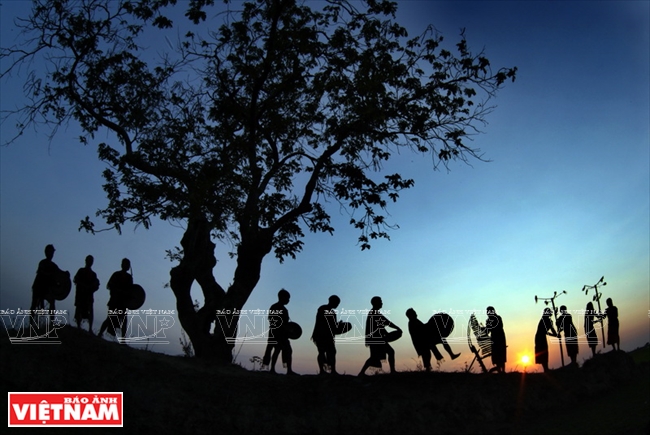 The cultural space of gongs in Tay Nguyen spreads over five provinces, including Kon Tum, Gia Lai, Dak Lak, Dak Nong and Lam Dong. The ethnic groups involved are the Ba Na, E De, Co Tu, M’Nong and Gia Rai. Photo: Cong Dat/VNP  The ethnic groups in the Central Highlands consider gongs to be their treasures, their voices and their inmost feelings and sentiments. Photo: Cong Dat/VNP The M’ Nong people in Jun hamlet, Lak district, Dak Lak province play gongs in their ceremony to pray for the health of their elephants. Photo: Cong Dat/VNP 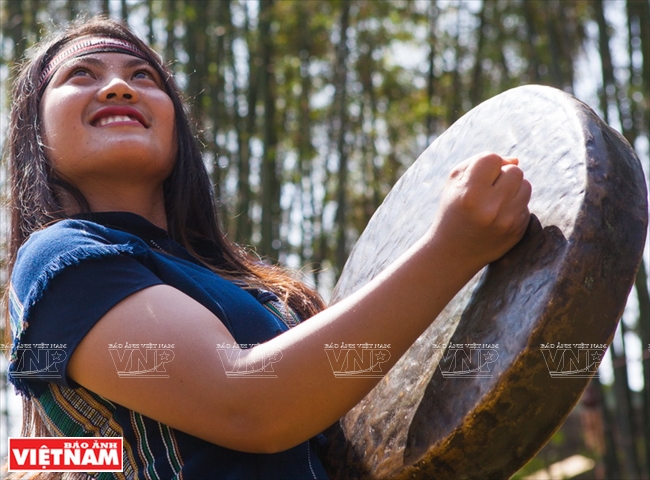 A Xo Dang girl plays a gong in a ceremony on setting up water pipes. Photo: Le Minh/VNP |
For Tay Nguyen ethnic people groups, gong tones and melodies are closely attached to lives of the locals. The sounds of gongs follow people from the time they are born to the time they breathe their last breath. Therefore, gongs are used at name-giving rites, new rice rituals, buffalo-stabbing rites, rain- praying rites, wedding ceremonies and house-warming parties. They are also the esoteric threads linking the earthly world with the divine world.
| Gongs are musical instruments made of bronze and classified into two kinds: one with a nipple in the middle and one without a nipple. They are made in different sizes, from 20cm to 60 or even 90 and 120cm in diameter. They can be used separately or in a set of 2 to 12, 13, 18 or even 20 pieces. |
For the E De ethnic people, gongs are not only musical instruments but also invaluable assets. “You are not a wealthy person if you do not have gongs even though you have multi-storey houses and cars,” Y Thim added.
Perhaps, for that reason, Y Thim is considered rich in Buon Ma Thuot because he has 20 sets of precious gongs. He said, “My house is not a museum, only a place where precious assets of the E De people are kept for our children and grandchildren as well as students and also for visitors to see and learn more about our ancestors’ culture”.
During our journey to Tay Nguyen, we were lucky to meet with village patriarch Y Tong Drang in Jun hamlet, Lak district, Dak Lak province. He welcomed us in a tipsy state after imbibing the festival drinks of Ruou can (wine drunk out of a jar through pipes) and told us, “ In the old days, a set of M’Nong people’s gongs was sold at a price equivalent to 7- 8 buffaloes. It was so precious that M’Nong people neither gave nor lent them to anyone”.
During our stay in Jun hamlet, the village patriarch guided us to a ritual praying for an elephant’s health at Dang Nang Long’s house. In his capacity as sorcerer and owner of an elephant herd, Dang Nang Long revealed that Tay Nguyen people think that everything has a soul and only gong sounds can call and link souls together. In the rites of praying for an elephants’ health, without gong sounds, the elephants’ soul does not know where to go.
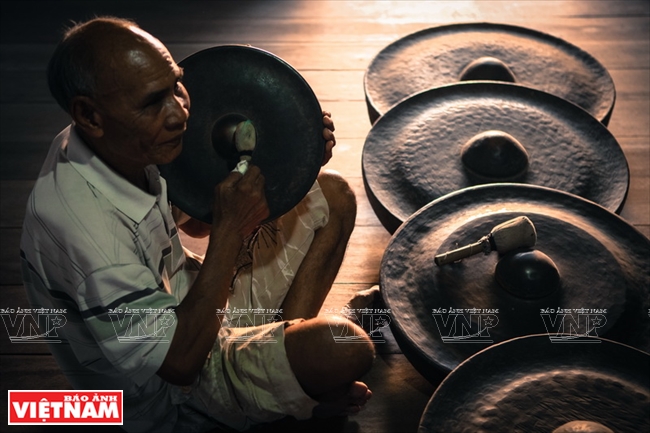 Hamlet patriarch Y Tong Drang in Jun hamlet tests sounds of gongs. Photo: Cong Dat/VNP 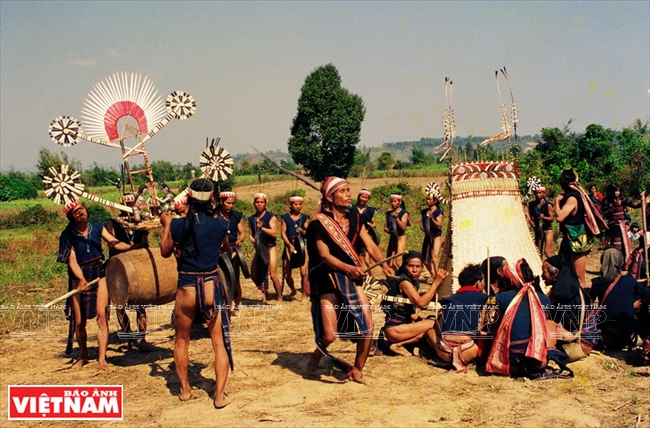 Playing gongs in the grave leaving ceremony of the Gia Rai people in the Central Highlands. Photo: VNP’s files Hamlet patriarch Y Tong Drang in Jun hamlet tests sounds of gongs. Photo: Cong Dat/VNP Folk artisans in the Central Highlands play gongs at the Vietnam National Village for Ethnic Culture and Tourism in Hanoi. Photo: Khanh Long/VNP 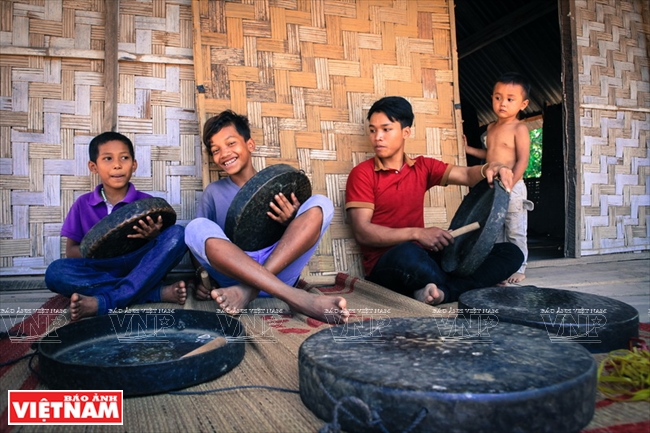 M’Nong children in Jun hamlet learn to play gongs. Photo: Cong Dat/VNP |
Dang Nang Long signalled the start of the rite with resounding gong tones. Surprisingly, giant and fierce elephants suddenly became gentle and well-behaved, obeying the mahouts’ direction and seriously joining in the rite without any trouble.
The interesting stories of Tay Nguyen gong culture led us to various areas of this windy highland. When travelling through each area, such stories were told more and more.
|
|
Tay Nguyen Calling Friends
Nowadays, gongs have become a peculiar cultural and tourist product of Tay Nguyen inhabitants. They constitute not only the thread linking hamlets together and humans with deities but also the sounds of hearts and souls of Tay Nguyen people calling friends from different regions of the world to discover the land rich in economic and cultural potentials.
That is why at a conference to promote investment in the Tay Nguyen region in 2017, Prime Minister Nguyen Xuan Phuc urged the local administration to work out a strategy on diverse tourist development, placing importance on the preservation of local culture represented by gong culture.
Fully aware of the role of gongs in cultural- tourist development, the authorities of Lam Dong, Dak Lak, Gia Lai, Kon Tum and Dak Nong provinces have recently made sound decisions and policies to preserve, maintain and develop the gong culture.
For instance in Da Lat, known as Tay Nguyen’s tourist “capital”, visitors have the chance not only to see beautiful places with clean air but also enjoy gong performances by Ma ethnic minority people in the Langbiang mountain region.
At the Tay Nguyen Gong Culture Festival 2017 in Buon Ma Thuot, visitors also had the opportunity to enjoy new tourist products of gong culture in four ancient hamlets of the E De people like Kram, Ale, Pan Lan and Ko Sia.
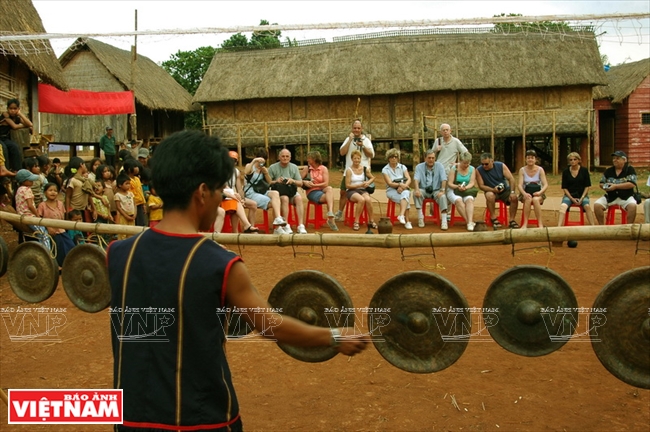 Foreign tourists enjoy a gong performance at a cultural village in Tay Nguyen.Photo: VNP’s file 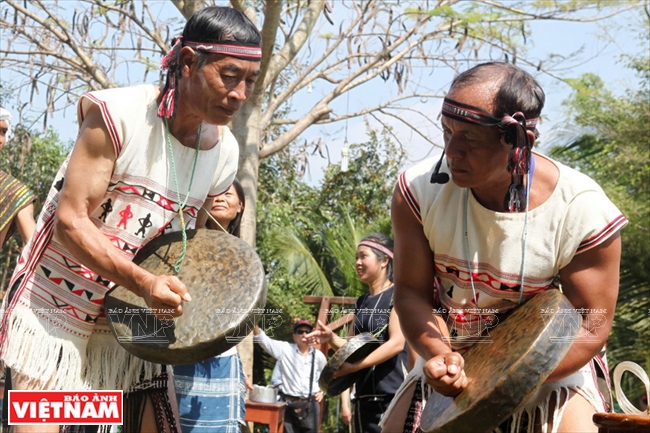 Performing gongs in a ceremony on setting up water pipes. Photo: Le Minh/VNP 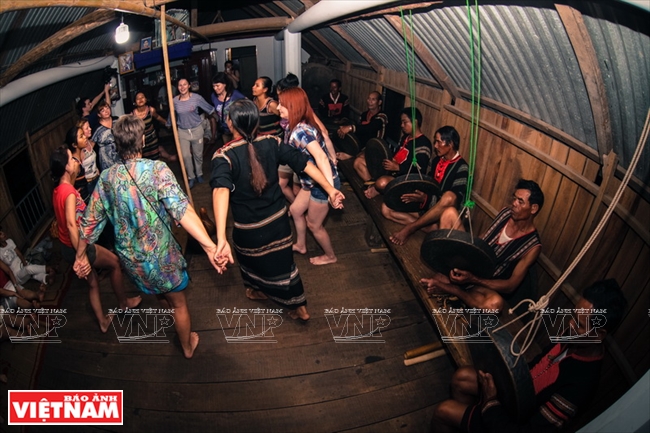 Foreign tourists dance to the sound of gongs performed by M’Nong artisans in their Nha dai (traditional long house). Photo: Cong Dat/VNP |
Following a group of Japanese tourists, we went to Ko Sia hamlet to enjoy the special gong performances by the E De people. We learned that just three years ago, with the assistance of the Culture, Sports and Tourism Department of Dak Lak province, village patriarch Ma Len and the Ko Sia hamlet gong team successfully organised a cultural- artistic program for visitors who came to discover the culture of the E De people. Since then, various tourist companies and agencies have established various tours, taking tourists to Ko Sia hamlet, thus helping diversify tourism in Tay Nguyen.
|
Tay Nguyen gong culture space was recognised on November 15, 2005 by UNESCO as the oral and intangible cultural masterpiece of humanity. Tay Nguyen gong culture space stretches over five provinces: Kon Tum, Gia Lai, Dak Lak, Dak Nong and Lam Dong. The subjects of this cultural space are people of different ethnic groups: E De, Gia Rai, Ba Na and Ma and the following components: gongs, musical pieces for gongs, gong performers and rituals and festivals with the use of gongs. |
At present, Ko Sia hamlet weekly welcomes dozens of delegations of visitors to enjoy gong performances and discover the special features of the E De people’s culture. At night, by the flickering fire and liquor jars with gong tunes and melodies in the background, visitors can hear deep voices, singing historical poems about such legendary figures as Dam San, Xing Nha, Dam Ji, Khing Ju and M’ Drong Dam.
During our trip, we also had a chance to travel with a group of French tourists to Lak district, some 60km from Buon Ma Thuot city, enjoying an exceptional night of special gong performances by the M’Nong people in the communal long house in Jun hamlet. The sweet gong tones and melodies were enjoyed by the European visitors with one surprise after another.
The legendarily bewitching gong sounds of Tay Nguyen people have travelled across Truong Son (Long Mountain range), reaching friends on five continents as a world- recognised cultural heritage, the oral intangible cultural masterpiece of humanity. This serves as a vehicle to bring the special cultural features of Tay Nguyen people of various ethnic groups to friends far and wide and also as an invitation to them to visit Tay Nguyen, a place rich in cultural traditions .
Story: Khanh Long - Photos: Le Minh, Cong Dat, Khanh Long & VNP’S files

